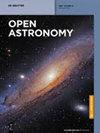海洋测高卫星Ka/C双频测距系统及电离层误差分析
IF 0.5
4区 物理与天体物理
Q4 ASTRONOMY & ASTROPHYSICS
引用次数: 0
摘要
摘要针对未来海洋测高卫星的发展趋势,提出了Ka/C双频组合系统的设计思路,即采用一个测高天线包含Ka和C频率(分别为35.7 GHz和5.3 GHz)进行组合测距的模式。首先,给出了测高度计相位中心到海面距离的随机误差模型,分析表明电离层校正误差是影响随机误差的重要因素之一。其次,对典型电离层参数的计算表明,电离层高阶项对高度计量程的影响小于mm级,可以忽略。分别给出了电离层误差一阶项和二阶项双频和三频校正的严格表达式。Jason-2和SARAL卫星的计算实验表明,Ku波段电离层误差校正的最大幅度可达11 cm, Ka波段电离层误差校正的最大幅度可达2 cm。对于高精度应用,必须对单个Ka频率进行电离层校正。采用Ka/C双频组合后,无需全球电离层图(GIM)模型即可直接进行误差校正,其精度将比GIM模型进一步提高。在1 Hz采样条件下,Ka/C组合的电离层校正精度可优于2.5 mm,基本消除了电离层的影响,考虑传播误差,总测距精度可达3.5 cm。本文章由计算机程序翻译,如有差异,请以英文原文为准。
Ka/C dual frequency ranging system for ocean altimetry satellite and analysis of ionospheric error
Abstract In view of the future development trend of ocean altimetry satellites, the design idea of Ka/C dual frequency combination system is proposed, that is, the mode of using an altimeter antenna to contain Ka and C frequencies (35.7 and 5.3 GHz, respectively) for combined ranging. First, the random error model of altimeter measuring the distance from the altimeter phase center to the sea surface is given, and the analysis shows that the ionospheric correction error is one of the important factors. Second, the calculation of typical ionospheric parameters shows that the influence of ionospheric higher order terms on altimeter ranging is below the mm level, and its influence can be ignored. The rigorous expression for the first-order and second-order term correction of ionosphere error are given, respectively, by using dual frequency and three frequencies. The computational experiment of Jason-2 and SARAL satellite show that the maximum magnitude of ionospheric error correction in Ku band can reach 11 cm, while the maximum magnitude of ionospheric error correction in Ka band can reach 2 cm. For high-precision applications, ionospheric corrections must be made for single Ka frequency. After Ka/C dual frequency combination is adopted, error correction can be directly conducted without global ionospheric map (GIM) model, and its accuracy will be further improved than GIM model. Under 1 Hz sampling conditions, the ionospheric correction accuracy of Ka/C combination can be better than 2.5 mm, basically eliminating the influence of the ionosphere, and the total ranging accuracy can reach 3.5 cm considering the propagation error.
求助全文
通过发布文献求助,成功后即可免费获取论文全文。
去求助
来源期刊

Open Astronomy
Physics and Astronomy-Astronomy and Astrophysics
CiteScore
1.30
自引率
14.30%
发文量
37
审稿时长
16 weeks
期刊介绍:
The journal disseminates research in both observational and theoretical astronomy, astrophysics, solar physics, cosmology, galactic and extragalactic astronomy, high energy particles physics, planetary science, space science and astronomy-related astrobiology, presenting as well the surveys dedicated to astronomical history and education.
 求助内容:
求助内容: 应助结果提醒方式:
应助结果提醒方式:


